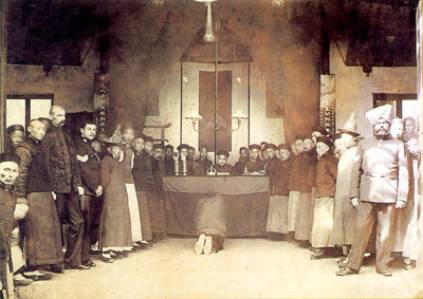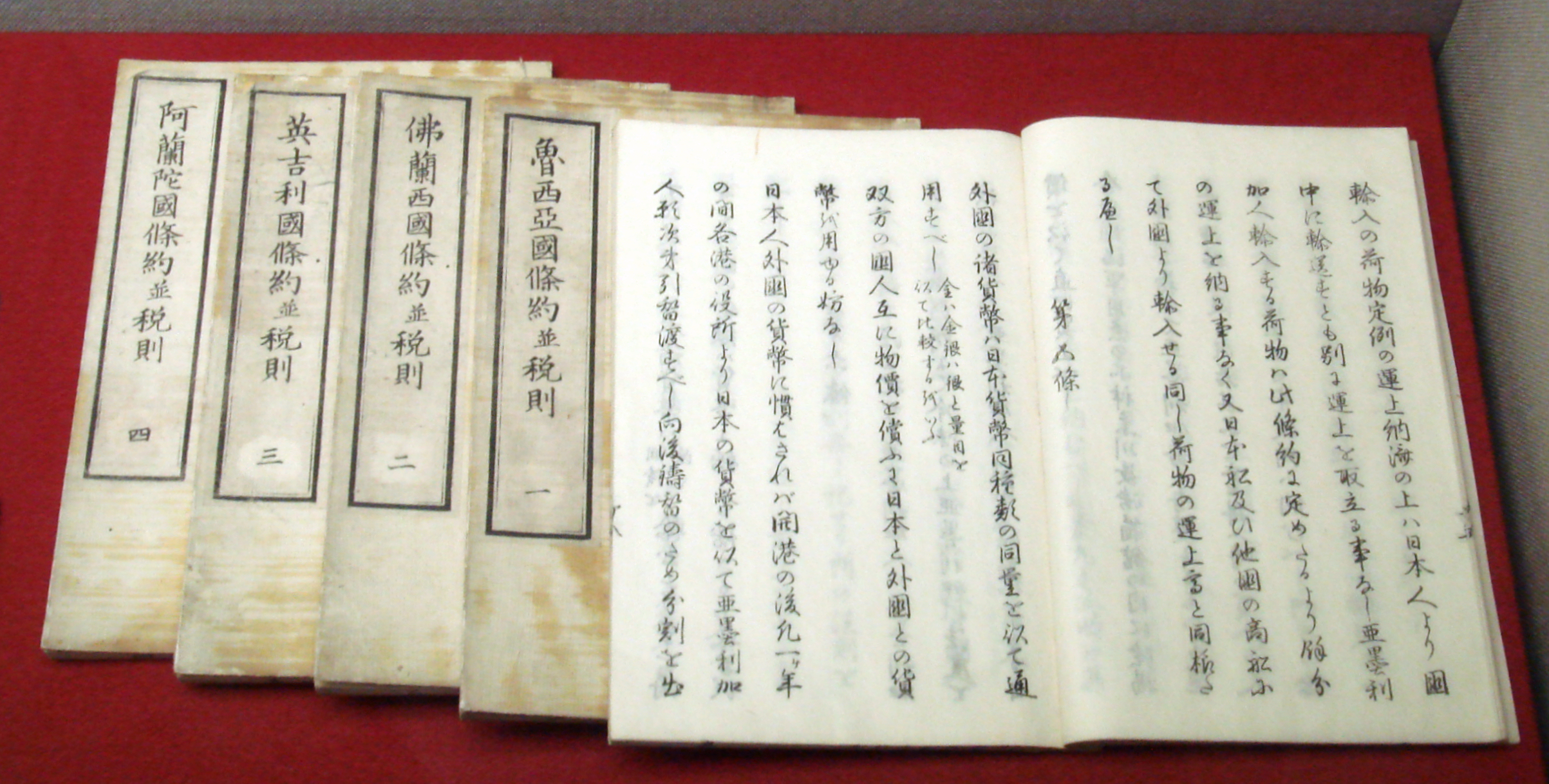|
Nagasaki Foreign Settlement
The Nagasaki foreign settlement (長崎居留地), sometimes called the Oura foreign settlement (大浦居留地), was an area in Nagasaki, Japan, settled by foreigners as Japan opened its doors to Western trade. The area was established by treaties between the West and Japan in the mid-to-late 1850s, and remained an important center of Western life in Japan until the outbreak of World War II. This settlement saw many firsts for Japan, including the first international telegraph and also the first use of a steam locomotive, the "Iron Duke," on a short track in the Oura district. Nagasaki holds a festival in mid-September that focuses on the foreign settlement. Development A series of encounters between the West and Japan in the 1850s ended Japan's isolationist trade policies. In particular, the treaty with Russia, signed on February 7, 1855 established Nagasaki as an open port and, further, granted extraterritoriality privileges to foreigners living in Japan. These encounters ... [...More Info...] [...Related Items...] OR: [Wikipedia] [Google] [Baidu] |
Nagasaki
is the capital and the largest city of Nagasaki Prefecture on the island of Kyushu in Japan. It became the sole port used for trade with the Portuguese and Dutch during the 16th through 19th centuries. The Hidden Christian Sites in the Nagasaki Region have been recognized and included in the UNESCO World Heritage List. Part of Nagasaki was home to a major Imperial Japanese Navy base during the First Sino-Japanese War and Russo-Japanese War. Near the end of World War II, the American atomic bombings of Hiroshima and Nagasaki made Nagasaki the second and, to date, last city in the world to experience a nuclear attack (at 11:02 am, August 9, 1945 'Japan Standard Time (UTC+9)'). , the city has an estimated population of 407,624 and a population density of 1,004 people per km2. The total area is . History Nagasaki as a Jesuit port of call The first contact with Portuguese explorers occurred in 1543. An early visitor was Fernão Mendes Pinto, who came from Sagres ... [...More Info...] [...Related Items...] OR: [Wikipedia] [Google] [Baidu] |
Extraterritoriality
In international law, extraterritoriality is the state of being exempted from the jurisdiction of local law, usually as the result of diplomatic negotiations. Historically, this primarily applied to individuals, as jurisdiction was usually claimed on peoples rather than on lands. Extraterritoriality can also be partly applied to physical places, such as the immunity granted to diplomatic missions, military bases of foreign countries, or offices of the United Nations. The three most common cases recognized today internationally relate to the persons and belongings of foreign heads of state and government, the persons and belongings of ambassadors and other diplomats, and ships in international waters. Forms In the past, pre-modern states generally claimed sovereignty over persons, creating something known as personal jurisdiction. As people move between borders, this led, in the framework of a territorial jurisdiction, to certain persons being under the laws of countries in w ... [...More Info...] [...Related Items...] OR: [Wikipedia] [Google] [Baidu] |
Ansei Treaties
The Ansei Treaties (Japanese:安政条約) or the Ansei Five-Power Treaties (Japanese:安政五カ国条約) are a series of treaties signed in 1858, during the Japanese Ansei era, between Japan on the one side, and the United States, Great Britain, Russia, Netherlands and France on the other.Auslin, p.1 The first treaty, also called the Harris Treaty, was signed by the United States in July 1858, with France, Russia, Britain and the Netherlands quickly followed within the year: Japan applied to the other nations the conditions granted to the United States under the "most favoured nation" provision. Content The most important points of these "unequal treaties" are: * Exchange of diplomatic agents. * Edo, Kobe, Nagasaki, Niigata, and Yokohama’s opening to foreign trade as ports. * Ability of foreign citizens to live and trade at will in those ports (only the opium trade was prohibited). * A system of extraterritoriality that provided for the subjugation of foreign resident ... [...More Info...] [...Related Items...] OR: [Wikipedia] [Google] [Baidu] |
Treaty Of Amity And Commerce (United States-Japan)
Treaty of Amity and Commerce may refer to: * Treaty of Amity and Commerce (United States–France) (1778) * Treaty of Amity and Commerce (United States–Dutch Republic), a 1782 United States treaty * Treaty of Amity and Commerce (United States–Sweden) (1783) * Treaty of Amity and Commerce (Prussia–United States) (1785) * Treaty of Amity and Commerce (United States-Siam) or Siamese-American Treaty of Amity and Commerce (1833) * Treaty of Amity and Commerce (U.K.-Siam) or Bowring Treaty (1855) * Treaty of Amity and Commerce (U.K.-Japan) or Anglo-Japanese Treaty of Amity and Commerce (1858) * Treaty of Amity and Commerce (France-Japan) (1858) * Treaty of Amity and Commerce (United States–Japan) or Harris Treaty (1858) * Treaty of Amity and Commerce (Prussia–Japan) (1861) * Treaty of Amity and Commerce (United States-Joseon/Korea) or Joseon-American Treaty of Amity and Commerce (1882) * Treaty of Amity and Commerce (China-Macau) or Sino-Portuguese Treaty ceding (1887) ... [...More Info...] [...Related Items...] OR: [Wikipedia] [Google] [Baidu] |
Thomas Blake Glover
Thomas Blake Glover (6 June 1838 – 16 December 1911) was a Scottish merchant in the Bakumatsu and Meiji period in Japan. Early life (1838–1858) Thomas Blake Glover was born at 15 Commerce Street, Fraserburgh, Aberdeenshire (council area), Aberdeenshire in northeast Scotland on 6 June 1838, the fifth of eight children, to Thomas Berry Glover (1806-1878), a coastguard officer from Vauxhall, London and Mary Findlay (1807-1887) from the parish of Fordyce, Banffshire. Thomas Blake Glover spent the first six years of his life in Fraserburgh, which was fast expanding as a fishing and trading port. In 1844, the family moved first to coast guard, coastguard stations at Grimsby, then Collieston in Aberdeenshire, then finally to the Bridge of Don, by Aberdeen, Thomas senior having by this time been promoted to Chief Coastguard Officer. Young Thomas was educated first at the recently opened parish school in Fraserburgh, then in primary schools in Grimsby, Collieston, and finally at t ... [...More Info...] [...Related Items...] OR: [Wikipedia] [Google] [Baidu] |
Dejima
, in the 17th century also called Tsukishima ( 築島, "built island"), was an artificial island off Nagasaki, Japan that served as a trading post for the Portuguese (1570–1639) and subsequently the Dutch (1641–1854). For 220 years, it was the central conduit for foreign trade and cultural exchange with Japan during the isolationist Edo period (1600–1869), and the only Japanese territory open to Westerners. Spanning or , Dejima was created in 1636 by digging a canal through a small peninsula and linking it to the mainland with a small bridge. The island was constructed by the Tokugawa shogunate, whose isolationist policies sought to preserve the existing sociopolitical order by forbidding outsiders from entering Japan while prohibiting most Japanese from leaving. Dejima would house Portuguese merchants and separate them from Japanese society while still facilitating lucrative trade with the West. Following a rebellion by mostly Catholic converts, all Portuguese w ... [...More Info...] [...Related Items...] OR: [Wikipedia] [Google] [Baidu] |
Glover Garden
Glover House known as ''Ipponmatsu'' (Single Pine Tree) from a drawing of 1863. The tree was chopped down in the early 20th century. is a park in Nagasaki, Japan, built for Thomas Blake Glover, a Scottish merchant who contributed to the modernization of Japan in shipbuilding, coal mining, and other fields. In it stands the Glover Residence, the oldest Western-style house surviving in Japan and Nagasaki's foremost tourist attraction. It is located on the Minamiyamate hillside overlooking Nagasaki harbor. It was built by Hidenoshin Koyama of Amakusa island and completed in 1863. It has been designated as an Important Cultural Asset. As the house and its surroundings are reminiscent of Puccini's opera, it is also known as the "Madame Butterfly House." Statues of Puccini and diva Miura Tamaki, famed for her role as Cio-Cio-san, stand in the park near the house. This house was also the venue of Glover's meetings with rebel samurai, particularly from the Chōshū and Satsuma do ... [...More Info...] [...Related Items...] OR: [Wikipedia] [Google] [Baidu] |
Treaty Of Amity And Commerce (United States–Japan)
The , also called the Harris Treaty was a treaty signed between the United States and Tokugawa Shogunate, which opened the ports of Kanagawa and four other Japanese cities to trade and granted extraterritoriality to foreigners, among a number of trading stipulations. It was signed on the deck of the in Edo (now Tokyo) Bay on July 29, 1858. Timeline * July 29, 1858: Treaty and Regulations are signed by the United States and Japan * December 15, 1858: Senate reviews the treaty and consents to ratification * March 19, 1859: Ratified by Japan * July 4, 1859: Entered into force * April 12, 1860: Ratified by the President of the United States * May 22-23, 1860: Ratifications exchanged at Washington and proclaimed by the President * June 25, 1866: Amended through convention * July 25, 1878: Modified by convention * July 17, 1899: Superseded by the treaty of November 22, 1894. The Treaty The treaty followed the 1854 Convention of Kanagawa, which granted coaling rights for Amer ... [...More Info...] [...Related Items...] OR: [Wikipedia] [Google] [Baidu] |
Ōura Church
The Basilica of the Twenty-Six Holy Martyrs of Japan (日本二十六聖殉教者聖堂) also is a Roman Catholic minor basilica and Co-cathedral in Nagasaki, Japan, built soon after the end of the Japanese government's Seclusion Policy in 1853. It is also known as the Church of the 26 Japanese Martyrs. For many years it was the only Western-style building declared a national treasure, and is said to be the oldest Christian church in Japan. History In 1863, two French priests from the Société des Missions Étrangères, Fathers Louis Furet and Bernard Petitjean, landed in Nagasaki with the intention of building a church honoring the Twenty-Six Martyrs of Japan, nine European priests and seventeen Japanese Christians who were crucified in 1597 by order of Toyotomi Hideyoshi. The church was finished in 1864. Constructed by the master carpenter of the Glover Residence, Koyama Hidenoshin, it was originally a small wooden church with three aisles and three octagonal towers. The ... [...More Info...] [...Related Items...] OR: [Wikipedia] [Google] [Baidu] |
Bakumatsu
was the final years of the Edo period when the Tokugawa shogunate ended. Between 1853 and 1867, Japan ended its isolationist foreign policy known as and changed from a feudal Tokugawa shogunate to the modern empire of the Meiji government. The major ideological-political divide during this period was between the pro-imperial nationalists called and the shogunate forces, which included the elite swordsmen. Although these two groups were the most visible powers, many other factions attempted to use the chaos of to seize personal power.Hillsborough, ''page # needed'' Furthermore, there were two other main driving forces for dissent: first, growing resentment on the part of the (or outside lords), and second, growing anti-Western sentiment following the arrival of Matthew C. Perry. The first related to those lords whose predecessors had fought against Tokugawa forces at the Battle of Sekigahara in 1600, after which they had been permanently excluded from all powerful pos ... [...More Info...] [...Related Items...] OR: [Wikipedia] [Google] [Baidu] |








